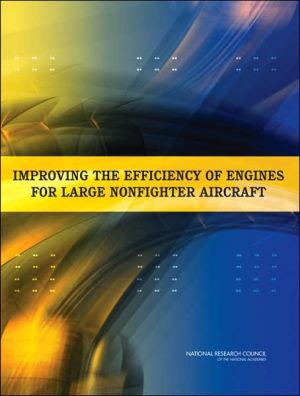

 |

|

Sold Out
Book Categories |
Contents
SUMMARY....................1
1 INTRODUCTION....................7
Study Origin....................7
Overview of Air Force Fuel Consumption and Cost Structure....................7
Lessons Learned from Previous Re-engining Programs....................11
Commercial Re-engining Programs....................11
Military Re-engining Programs....................11
Complexity of Re-engining Aircraft....................11
Program Schedule and Cost....................12
Potential for Future Re-engining Programs....................12
Force Structure for Future Study....................13
Additional Context....................13
Previous Re-engining Studies....................13
Air Force Scientific Advisory Board Study on Technology Options for Improved Air Vehicle Fuel Efficiency....................14
Summary....................17
References....................17
2 SELECTION OF CANDIDATES....................18
Determining Factors....................18
Fleet Size....................18
Length of Service in Inventory....................18
Fuel Consumption Rate....................20
Aircraft Utilization Rate....................20
Maintenance and Support Costs....................21
Plausibility of Significant Improvements....................22
Treatment of Additional Operational Benefits....................23
List of Candidate Aircraft and Methodology for Selection....................23
Summary Candidates for Study....................25
References....................25
3 PROPOSED ENGINE MODIFICATIONS AND RE-ENGINING....................26
KC-135 R/T Aircraft....................26
C-130Aircraft....................29
B-1 Aircraft....................33
Modification....................33
Re-engining....................33
Fuel Consumption....................36
KC-10 Aircraft....................36
Background....................36
Technology Infusion Benefits....................36
High-Pressure Turbine Upgrades....................37
Commonality Considerations for the Air Force Engine Fleet....................37
Commonality Issues for the Commercial Engine Fleet....................37
Summary....................38
C-17 Aircraft....................38
References....................39
4 TF33 SERIES POWERED AIRCRAFT....................40
Introduction....................40
E-8C JSTARS Weapons System....................41
E-3 AWACS Platform....................45
B-52 Aircraft....................48
KC-135 Aircraft....................50
References....................53
5 RECURRING AND NONRECURRING COST ESTIMATIONS....................55
Analysis Approach....................55
Nonrecurring Costs....................56
Recurring Costs....................56
Costs and Benefits to Operations and Support....................56
Maintenance and Fuel Savings....................57
Methodology and Basis for the Estimate....................57
Fuel Consumption....................58
Engine Repair Cost....................59
Assumptions, Inputs, and Data....................59
Net Present Value Analysis....................63
Summary....................65
References....................68
6 OTHER CONSIDERATIONS....................69
Aerodynamic Modifications....................69
Winglets....................69
Laminar Flow Nacelles....................72
Airframe Modifications for Fuel Savings Unique to the C-130....................72
Optimization of Operations....................73
Maintenance Practices....................74
On-Wing Programs....................76
Engine Maintenance Programs....................77
Information, Data Requirements, and Organizational Structure....................77
Operational Practices....................78
Aircraft Weight Management....................79
Other Benefits of Re-engining....................80
Operational Benefits....................80
Environmental Considerations and Implications....................83
References....................85
7 ALTERNATIVE FUELS....................87
Background....................87
Synthetic Fuel Properties, Specifications, and Re-engining....................88
Challenges to Producing Domestic Alternative Fuels....................90
Strategy for Qualifying Alternative Fuels....................93
Coal-to-Liquid Fuel Technology Promotion Act....................94
Summary....................95
References....................95
8 TECHNOLOGY PREPAREDNESS AND INSERTION....................96
Introduction....................96
Turbine Engine Science and Technology Overview....................97
Potential for Specific Fuel Consumption Improvement....................99
Component Improvement and Engine Model Derivative Programs....................100
Turbine Engine Science and Technology Funding....................103
References....................104
9 ACQUISITION, FINANCING, AND SUPPORT....................106
Introduction....................106
Overview of Options....................107
Options in Group 1....................107
Option 1: Maintain All Commercial Derivative Engines to FAA Standards....................109
Option 2: Compete All Maintenance Contracts....................110
Option 3: Create a Line Item in the Defense Budget....................111
Option 4: Implement a Fuels Savings Performance Contract Strategy....................111
Options in Group 2....................113
Option 5: Re-engine Air Force Aircraft with Commercial Engines and Lease or Resell the Engines When the Airframe Is Retired....................113
Option 6: Create a Spare Engine and Parts Pool....................116
Option 7: Lease Engines on a Long-Term Basis....................116
Option 8: Lease Engines on a Short-Term Basis....................117
Options in Group 3....................119
Option 9: Sale and Leaseback on a Long-Term Basis....................119
Option 10: Sale and Leaseback on a Short-Term Basis....................120
References....................122
APPENDIXES A Biographical Sketches of Committee Members....................125
B Meetings and Speakers....................133
C Key Recommendations from Previous Studies....................138
D Background Information on Re-engining Requirements....................152
E Background Information on Lessons Learned from Previous Re-engining Programs....................159
F Background Information on Re-engining the C-130....................165
G Sensitivity Analysis....................169
Login|Complaints|Blog|Games|Digital Media|Souls|Obituary|Contact Us|FAQ
CAN'T FIND WHAT YOU'RE LOOKING FOR? CLICK HERE!!! X
 You must be logged in to add to WishlistX
 This item is in your Wish ListX
 This item is in your CollectionImproving the Efficiency of Engines for Large Nonfighter Aircraft
X
 This Item is in Your InventoryImproving the Efficiency of Engines for Large Nonfighter Aircraft
X
 You must be logged in to review the productsX
 X
 X

Add Improving the Efficiency of Engines for Large Nonfighter Aircraft, Because of the important national defense contribution of large, non-fighter aircraft, rapidly increasing fuel costs and increasing dependence on imported oil have triggered significant interest in increased aircraft engine efficiency by the U.S. Air Forc, Improving the Efficiency of Engines for Large Nonfighter Aircraft to the inventory that you are selling on WonderClubX
 X

Add Improving the Efficiency of Engines for Large Nonfighter Aircraft, Because of the important national defense contribution of large, non-fighter aircraft, rapidly increasing fuel costs and increasing dependence on imported oil have triggered significant interest in increased aircraft engine efficiency by the U.S. Air Forc, Improving the Efficiency of Engines for Large Nonfighter Aircraft to your collection on WonderClub |